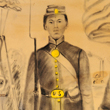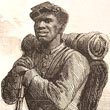The Civil War in Missouri
Save ThisMy CollectionThe Battle of Island Mound and African American Soldiers

Private Elijah Madison, Company F, 68th Infantry, U.S. Colored Troops (Download 1.1 MB PDF)
Highlights
- At the beginning of the war, President Lincoln refused to accept ex-slaves and free African Americans into military service. He feared angering border states such as Missouri and Kentucky. In addition, he knew that the majority of Northerners were opposed to African American troops because of racial bias.
- As the war raged on, the idea of enlisting African Americans as soldiers grew in popularity. Lincoln moved incrementally. He passed multiple confiscation acts that allowed for enslaved Southerners to be taken into the Federal army. Still, he refused to allow African American troops to engage in battle.
- The first African American regiment was raised by Col. James Montgomery in South Carolina, but Lincoln forced it to disband because he still feared angering slaveholders in border states.
- The 1st Kansas was authorized by General James H. Lane on August 4, 1862.
Battle of Island Mound
Highlights
- From October 27 to October 29, 1862, the 1st Kansas endured several skirmishes with Confederate guerrillas. These skirmishes became known as the Battle of Island Mound and signified the first time an African American unit engaged an enemy in combat.
- The 1st Kansas was sent to Missouri from Bourbon County, Kansas, on Sunday, October 26, to combat guerrillas operating from “Hog Island.” Capt. H. C. Seaman led the regiment, which numbered approximately 250 men.
- On Monday, October 27, the 1st Kansas crossed into Missouri at Dickey’s Crossing and occupied a farm owned by Enoch Toothman, a suspected Southern sympathizer and guerrilla. The farm was dubbed “Fort Africa.”
- Almost immediately, the regiment engaged the enemy in long-range skirmishes. By Tuesday, October 28, the 1st Kansas sent for reinforcements.
- The fighting intensified the next day with hand-to-hand fighting, when guerrillas attacked Fort Africa. Although outnumbered, they drove the enemy back. Reinforcements arrived the next day.
- On Thursday, October 30, they found that the guerillas’ camp had been abandoned. The enemy had fled to avoid a collision with the reinforced regiment.
- The victory of the 1st Kansas encouraged their muster into Federal service months later on January 13, 1863. After December 13, 1864, they were designated the 79th United States Colored Troops. They served for the remainder of the war.
Aftermath
Highlights
- Eventually, 166 African American regiments were raised. They were recruited voluntarily and through the draft.
- African American soldiers had a profound impact on the war. They fought and died for the cause of freedom. Through their heroic acts, they encouraged the passing of the Emancipation Proclamation and thus the end of slavery.
Primary Resources

"Two Slave Hunters Expelled from the
Camp of the 22nd Illinois Volunteers" (Download 1.8 MB PDF)
Camp of the 22nd Illinois Volunteers" (Download 1.8 MB PDF)

Private Elijah Madison, Company F, 68th Infantry,
U.S. Colored Troops (Download 1.1 MB PDF)
U.S. Colored Troops (Download 1.1 MB PDF)

"The Escaped Slave in the Union Army" (Download 1.4 MB PDF)
Topics